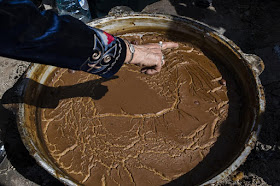Ruin porn, who can resist it? Our imagination gets sucked in by the crumbling walls, finding the memories of older lives carelessly abandoned on the floor. The ultimate demise of all that is, splayed out in front of us in an orgy of dust, cement and reinforced steel peeping through the cracks.
If I know anything about the Central Asia traveler, I know this much: she can appreciate a good ruin. Visiting ruins is a great way to learn about the recent history of the region, the Soviet program of industrialisation and collectivisation, the Lenin cult, Modernist architecture, etc. This map should get you on your way.
Kyrgyzstan
Smiling nomads in yurts and horses galloping on the jailoo? Perhaps. But in equal measure: abandoned mines, factories, collective farms and Lenins, and a couple of radioactive waste sites spreading like spilt milk.
• Ak-Tuz: Ore-dressing and processing enterprise. Now 4,7 millions cubic metres of radioactive waste is buried here.
• Inylchek: Top ghost town. Population from 15 000 down to 15. Impossible location. Permit needed.
• Min-Kush: Very depressing former uranium and coal mining town
• Jergalan: former coal mining town
• Mailuu-Suu: Uranium wastes buried in former mining town
• Balykchy: Former industrial port
 |
| Inylchek, Kyrgyzstan: Top ghost town. Population from 15 000 down to 15. Image: Yuri Boyanin |
Kazakhstan
Ruins of collective farms can be seen all throughout the country, and unused factories can be found in pretty much every town and city, big or small. For ghost towns, the north of Kazakhstan is a treasure trove. We have listed some of the most famous objects like Alga, Balkhash-9, missile defense complex Argun and Baikonur Site 110 on the map.
Visiting military facilities is of course highly illegal, and buildings in disrepair are prone to collapse. Visit at your own risk.
For the Aral Sea: On the Kazakh side, there are still a few remains of ships in the desert at the Ship Graveyard, but most have been taken out. Visiting the Uzbek side is more cost-effective and perhaps more interesting/atmospheric/depressing.
Kurchatov and the surrounding Semipalatinsk Test Site are the sites of the atomic bomb tests of the Soviet Union. Possible to visit, with a permit.
 |
| Alga - another ghost town. Once a famous Soviet, chemical phosphate plant in Kazakhstan. Image: Red Fury Star |
Uzbekistan
• Aral Sea: A few puddles remain on the Uzbek side, otherwise it’s desert everywhere.
• Angren: former coal mining town, now largely abandoned
• UzBum : former Soviet paper factory, in Tashkent. Possible to visit with special permission. Tours occasionally organised by X-Places.
 |
| UzBum - Tashkent's closed paper factory. Image: Eugene Panov |
Related posts:
Holidays in Soviet Sanatoriums
Tashkent Nostalgie - Eugene Panov's Exhibition, Tashkent
Uzbekistan's Decorative Architectural Panels
Seismic Modernism - Architecture and Housing in Soviet Tashkent
Lenin Still Points the Way in Bishkek, Kyrgyzstan


